Posts tagged ‘productivity’
Use Narrow Aisle Forklifts for Peak Efficiency
Efficiency is critical in warehouse operations. One way to maximize efficiency is to use narrow aisle forklifts. These specialized forklifts navigate tight spaces and narrow aisles, making them ideal for warehouses with limited space. This article will discuss the different types of narrow aisle forklifts and offer tips on using them effectively.
Types of Narrow Aisle Forklifts
There are three main types of narrow aisle forklifts: reach trucks, order pickers, and very narrow aisle forklifts. Each type has unique features and benefits; choosing the right one for your warehouse depends on your needs.
Reach Trucks
Reach trucks are the most common type of narrow aisle forklifts. They reach high shelves and lift loads to 30 feet. Their narrow chassis and telescoping mast allow them to navigate tight spaces. The reach mechanism extends the forks to reach the load.
One of the main advantages of reach trucks is their ability to lift heavy loads to great heights. They are also highly maneuverable, making them ideal for warehouses with narrow aisles. However, reach trucks are typically unsuitable for outdoor use and are best for smooth, flat surfaces.
Order Pickers
Order pickers, or stock pickers, are designed for order picking and inventory management. They have a platform that allows the operator to stand on and a set of forks that raise and lower to pick items from shelves. Order pickers are ideal for warehouses with high shelves and a high volume of orders.
One of the main advantages of order pickers is their ability to reach high shelves while allowing the operator to have a clear view of the load. They are also highly maneuverable and can navigate through narrow aisles. However, order pickers have a limited load capacity and are unsuitable for outdoor use.
Very Narrow Aisle Forklifts
Very narrow aisle forklifts, or turret trucks, are the most specialized type of narrow aisle forklift. They are designed to operate in aisles as narrow as 5 feet and can reach heights up to 40 feet. They have a rotating mast that allows them to turn in the aisle and pick up loads from either side.
One of the main advantages of very narrow aisle forklifts is their ability to operate in extremely narrow spaces, making them ideal for warehouses with limited space. They also have a high lift capacity and can reach great heights. However, they are more expensive than other types of forklifts and, as with any new forklift model added to your fleet, require specialized training to operate.
How to Use Narrow Aisle Forklifts Effectively
Now that we have discussed the different types of narrow aisle forklifts let’s look at some tips for using them effectively in your warehouse.
Proper Training
The first and most crucial step in using narrow aisle forklifts effectively is ensuring that all operators receive training. Operating a forklift requires specialized skills and knowledge; all operators must be trained and certified before using them.
Training should cover safety procedures, load capacity, and proper forklift operation. Providing refresher training is also essential to ensure operators learn the latest safety protocols and techniques.
Need forklift certification in Los Angeles County? We offer a comprehensive forklift certification program in Los Angeles at our location or yours. We also provide Train the Trainer courses, refresher courses, and group classes. Learn more and sign up here.
Inspect the Forklift Before Use
Before using a narrow aisle forklift:
- Inspect it for potential issues.
- Check the tires, brakes, and hydraulic system to ensure everything works.
- If you see problems, discontinue use until they are resolved.
Plan Your Route
When operating a narrow aisle forklift, planning your route before starting is essential to avoid obstacles and navigate aisles more efficiently. You should also be aware of hazards such as low-hanging objects or uneven surfaces.
Use the Forklift’s Features
Each type of narrow aisle forklift has unique features that can help you operate it more effectively. For example, reach trucks have a reach mechanism that allows them to pick up loads from a distance, while order pickers have a platform enabling the operator to stand on and have a clear view of the load.
Familiarize yourself with the features of the forklift you are using and use them to increase efficiency and safety.
Follow Safety Protocols
Safety should always be a top priority when operating a forklift. Follow all safety protocols, such as wearing a seatbelt, using the horn when approaching blind corners, and keeping a safe distance from other forklifts and pedestrians.
It is also important never to overload the forklift and always to use the proper attachments to lift the load.
Need a refresher on OSHA’s forklift safety rules and regulations? Visit OSHA’s website or read our blog post, Key OSHA Forklift Training Rules You Need to Know.
Narrow aisle forklifts are an asset for warehouses with limited space. By choosing the right type of forklift and following proper training and safety protocols, you can effectively increase efficiency and productivity in your warehouse operations. Always inspect the forklift before use and use its features to your advantage. With these tips, you can make the most of your narrow aisle forklifts and improve your warehouse operations.
Want to rent a narrow aisle forklift before you buy it? TMHS offers daily, monthly, or long-term rental needs from our over 1000+ rental units available. All rental equipment includes maintenance. You also get our rental replacement guarantee, which means if your rental equipment is down for more than 24 hours, a replacement unit is provided at no additional cost. Learn more and request a rental quote here.
Why You Need the Right Forklift Parts
Ensuring your Toyota Forklift’s performance and longevity involves more than maintenance; it hinges on the quality of the spare parts you choose. While forklift parts may seem simple, their impact on performance and efficiency is substantial. In this blog post, we look into the advantages of using Toyota Genuine Parts to maximize the value of your forklift.
The Value of Toyota Genuine Parts
- Unmatched Quality, Durability, and Reliability: Toyota Genuine Parts embodies the same commitment to quality, care, materials, and attention to detail as the forklifts they support. By choosing original parts, you invest in components designed to uphold the renowned Toyota standard.
- Long-term Value: Although the upfront cost may be higher, the long-term value of Toyota Genuine Parts becomes evident through enhanced durability, reliability, and extended lifespan. You’re not just replacing parts; you’re securing an investment in the performance of your forklift.
- Extended Lifespan of Your Forklifts: Genuine parts align with the entire forklift system, promoting longevity and minimizing the risk of unexpected breakdowns. By choosing Toyota Genuine Parts, you contribute to the extended lifespan of your forklifts, reducing the frequency of replacements and associated costs.
- Industry-Leading Warranty Coverage: Toyota Material Handling Solutions stands behind the quality of its Genuine Parts with an industry-leading warranty. Any Toyota part found to be defective under regular use is eligible for replacement or repair within a generous two-year or 4,000-hour timeframe. Significantly, warranty repairs or replacements performed by Toyota Certified Technicians incur no additional charges during this period.
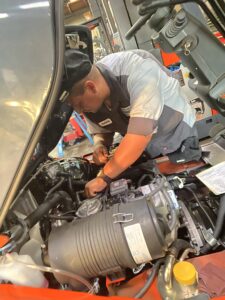
- Optimal Performance and Uptime: Genuine parts complement the intricacies of your Toyota forklift. By choosing these parts, you ensure optimal performance, reduced downtime, and increased overall uptime for your fleet. Toyota Genuine Parts enhances productivity and facilitates a more efficient and streamlined operation.
- Customer Satisfaction: Quick order fulfillment is vital in today’s fast-paced business environment. With Toyota Genuine Parts, you minimize delays, meet customer demands promptly, and safeguard your reputation for timely deliveries.
- Innovation Opportunities: Uninterrupted operations save valuable time for essential tasks and innovations. Investing in genuine spare parts empowers your team to focus on productivity and improvements rather than grappling with downtime-related challenges.
StarLift Program for Mixed Fleets
Through our StarLift Program, Toyota Material Handling Solutions caters to businesses with mixed fleets, offering forks, oils/chemicals, batteries, tires, and other replacement parts. The program ensures compatibility with various manufacturers while maintaining the quality synonymous with Toyota.
Elevate your forklift’s performance, extend its lifespan, and minimize downtime by choosing Toyota Genuine Parts. For inquiries about how these parts can enhance your uptime and overall operational success, contact us at (800) 794-5438 or complete this form. Make a strategic investment in the longevity and efficiency of your material handling equipment with Toyota Genuine Parts.
Watch a video to learn more about Toyota Genuine Parts.
Key OSHA Forklift Training Rules You Need to Know
In workplace safety, adherence to Occupational Safety and Health Administration (OSHA) standards is paramount to creating secure and healthy working conditions. Failure to comply with OSHA regulations can result in severe consequences and fines. Among OSHA’s crucial regulations are those governing forklift operations, emphasizing the importance of proper training to mitigate risks and maintain a secure work environment. This blog post provides a comprehensive overview of OSHA’s rules for forklift training, offering clarity to businesses seeking compliance.
Let’s dive into understanding OSHA’s Forklift Training Rules.
Age Requirement for Forklift Operators
OSHA mandates that individuals must be at least 18 to operate a forklift in non-agricultural operations. This age restriction is in place to ensure operators possess the maturity and responsibility necessary for safe forklift operation.
Driver’s License Requirement for Forklift Drivers
Unlike driving a car, according to OSHA requirements, forklift operators do not need a valid state driver’s license. The focus is on specialized training and certification tailored to the specific forklift used in the workplace.
Training Frequency for Forklift Operators
OSHA requires additional training in the event of a poor evaluation, changes to the work environment, or a transition to a different type of forklift. This flexibility allows businesses to tailor training schedules to their specific needs.
Recertification Interval for Forklift Drivers
OSHA requires the evaluation of every forklift operator at least once every three years to ensure that operators remain proficient in their skills and are aware of any updates or changes in safety protocols.
New Lift Trucks and Recertification
Operators do not require recertification when transitioning to a newer model of the same type of forklift. However, introducing an entirely new type of forklift necessitates thorough training before operation, ensuring operators can handle the specific characteristics of the new equipment.
Hand Pallet Jacks Certification 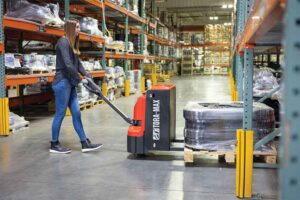
OSHA categorizes small hand pallet jacks as industrial trucks, underscoring the need for certification. Despite their compact size, Hand Pallet Jacks can cause harm if not operated correctly.
Golf Cart Operation
OSHA does not regulate golf carts. However, maintaining a safe workplace involves providing training for employees operating golf carts, emphasizing adherence to manufacturer guidelines for safe usage.
Forklift Operator Safety Training Programs
Companies are encouraged to invest in comprehensive forklift operator safety training programs. Training should cover theoretical knowledge and practical skills, ensuring operators are well-prepared for real-world scenarios.
Get Forklift Certification in LA County
We have a comprehensive operator safety training program with classroom and hands-on instruction. Using this program, our professional trainers provide your employees with the latest OSHA regulations, plus classroom and hands-on instruction on proper lift truck operation.
We provide training at our location on the 1st and 3rd Friday of every month at 8 am. We also offer Train the Trainer courses, refresher courses, and group classes at your location. We’re happy to use your equipment in your warehouse for the best results. Click here to book operator safety classes today!
Maintaining OSHA compliance is essential for safeguarding employees and the overall success of your business. Regularly check OSHA’s website for the latest rules and regulations. If you have any questions, contact us to schedule a free safety inspection to ensure a safe and compliant workplace.
How to Manage Spare Forklift Parts
Effective forklift maintenance is indispensable for any business relying on material handling equipment. The key to reducing downtime and ensuring smooth operations is strategically managing critical spare parts within your facility. This blog post explores the importance of keeping essential forklift components on-site, enabling businesses to address issues, minimize disruptions, and enhance efficiency.
The Cost of Downtime
Unplanned downtime can be a significant financial burden for businesses, affecting productivity, customer satisfaction, and the bottom line. When a forklift malfunctions, every minute counts, and delays in sourcing replacement parts can escalate costs and disrupt workflow.
Identifying Critical Forklift Parts
- Frequent Replacements: Identify the parts you replace most frequently during routine maintenance. Make sure to include components that undergo regular wear and tear in the course of daily operations.
- Urgency of Replacement: Evaluate how often you need specific parts. Critical parts are those whose immediate availability is essential to avoid prolonged downtime.
- Business Impact: Consider the broader impact on your business if a particular part is unavailable. If the absence of a specific component significantly hampers operations, it qualifies as a critical part.
Benefits of On-Site Spare Parts
- Swift Response: Keeping critical spare parts on-site allows for immediate response to forklift issues. Technicians can quickly access the necessary components, reducing the time needed to get the equipment back in operation.
- Cost Efficiency: By maintaining an inventory of essential parts, businesses can avoid costly overnight shipping charges and emergency procurement expenses. Having parts readily available minimizes the financial impact of unexpected breakdowns.
- Continuous Operations: With on-site spare parts, businesses can maintain continuous operations even when facing forklift malfunctions. The ability to fix a forklift ensures a seamless workflow, preventing disruptions in supply chains and meeting customer expectations.
Developing a Spare Parts Strategy
- Regular Audits: Conduct regular audits of your forklift fleet and update the list of critical spare parts based on usage patterns and equipment specifics.
- Strategic Inventory Management: Implement a robust inventory management system to track the availability and condition of spare parts to help replenish stock proactively.
- Collaboration with Suppliers: Establish relationships with reliable suppliers, like Toyota Material Handling Solutions, to ensure a steady and timely supply of critical parts when needed.
Proactively managing critical spare parts on-site is fundamental to effective forklift maintenance. By investing in a strategic spare parts strategy, businesses can minimize downtime, optimize operational efficiency, and ultimately contribute to a more resilient and profitable operation. Prioritize preparedness today to secure tomorrow’s uninterrupted flow of your material handling processes.
What You Need To Know About Forklift Fork Maintenance
Welcome to our comprehensive guide on forklift fork inspections and maintenance. As an integral component of forklifts, fork maintenance is essential to ensure optimal performance and minimize workplace risks. In this blog post, we delve into the frequently asked questions about inspecting forklift forks, daily checks, and common causes of damage. Whether you’re a forklift operator, warehouse manager, or safety supervisor, understanding these crucial aspects will contribute to a secure working environment and the prolonged lifespan of your forklift forks.
1. Why is it essential to inspect forklift forks daily?
Regular daily inspections of forklift forks are crucial to prevent potential hazards such as snapped forks, dropped loads, and injuries. Additionally, OSHA mandates daily inspections for all powered industrial trucks, including forks, to ensure workplace safety. Neglecting these inspections can lead to severe consequences.
2. How do forks typically get damaged?
Forks can sustain damage through various means, including:
- Wear from regular use
- Improper chain adjustments
- Minor accidents
- Fork use beyond rated capacity
- Driving with forks touching the floor
- Using a lifting chain on one fork to lift heavy objects
- Picking up loads too far out on the forks
- Attachments that stress the forks
3. What should you look for during a forklift fork inspection?
During a forklift fork inspection, pay attention to the following:
- Surface cracks: No cracks should be present on the forks, especially in the heel area and welds.
- Blade and shank angle: Check the angle between the blade’s upper face and the shank’s front face and replace the forks if the angle exceeds 93%.
- Straightness: Replace forks if they are bent more than 0.5% of the corresponding blade length or shank height.
- Fork tip height: Ensure that forklift blades are the same height and replace forks if there’s a noticeable difference between the tips.
- Positioning lock: Check the positioning lock or fork retention device to prevent malfunctions that could lead to accidents.
- Fork thickness: Use forklift calipers to measure the thickness of the fork blade, heel, and hook, replacing them if there is a 10% decrease, which reduces load capacity by 20%.
- Capacity stamp: The capacity stamps should always be visible on the forks.
4. How often should a professional technician inspect forklift forks?
Forklift forks should undergo a thorough inspection by a qualified service technician at least once a year to ensure optimal safety and performance.
5. How can I schedule a forklift inspection?
Our experienced technicians are available to inspect your forklifts and forks to ensure efficient and safe working conditions. Contact us to set up a service appointment today!
What You Need To Know About Cold Storage Applications
Operating a forklift in a cold storage environment has unique challenges and safety considerations. This blog post will address common questions about forklift operations in cold storage applications to ensure safety, efficiency, and productivity in these demanding conditions.
1. What are the main challenges of operating a forklift in a cold storage environment?
Cold storage environments present challenges like reduced battery performance, slippery surfaces, and decreased visibility due to condensation or frost on the forklift and racking. Forklift operators must also contend with the risk of hypothermia and frostbite.
2. How are forklift batteries affected by cold temperatures, and what can you do to mitigate this?
Cold temperatures can reduce the efficiency and capacity of forklift batteries. It’s essential to keep batteries warm when not in use, use battery blankets or heated storage, and ensure proper charging procedures. Additionally, consider using lithium-ion batteries that are less affected by cold temperatures than traditional lead-acid batteries.
3. What safety precautions should forklift operators take in cold storage facilities?
Operators should wear appropriate cold-weather gear, including insulated clothing, gloves, and headgear. Maintain clear visibility by regularly defrosting or clearing condensation from the windshield and ensuring good lighting in the facility. Take frequent breaks to avoid exposure to extreme cold and prioritize safety above all else.
4. What kind of tires work best on forklifts in cold storage applications?
In cold storage applications, it’s advisable to use non-marking tires designed for indoor use. As the name suggests, these tires are less likely to leave marks on the floor and provide better traction on icy or wet surfaces.
5. Are there specific forklift options or modifications for cold storage use?
Yes, options and modifications like heated cabins, additional lighting, and non-slip mats can improve safety and efficiency in these challenging conditions. Make sure any options or modifications are compliant with safety regulations.
6. How should forklift operators adjust their driving techniques in cold storage facilities?
Operators should drive more slowly and cautiously in cold storage environments due to reduced traction. Be mindful of potential ice patches and use gentle, controlled movements. Avoid abrupt starts and stops to prevent accidents.
7. How can forklift maintenance be adapted for cold storage conditions?
Regular forklift maintenance is crucial. Ensure the forklift’s heating system, defrosters, and lighting are in top condition. Use lubricants and fluids rated for cold temperatures and implement a preventive maintenance schedule to address cold-related wear and tear.
8. What role does proper training play in forklift operation within a cold storage facility?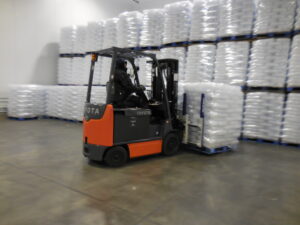
Proper training is paramount. Forklift operators should receive specialized training that covers the unique challenges of cold storage environments, including the impact of cold temperatures on equipment and safety procedures specific to these conditions.
Forklift operators in Los Angeles County can sign up for forklift certification training in Santa Fe Springs on the first and third Friday of every month.
9. Are there regulations or standards for forklift operation in cold storage facilities?
While there are no specific regulations solely for cold storage, general forklift safety regulations apply. Additionally, it’s essential to adhere to regulations related to cold storage safety, such as maintaining emergency exits and fire suppression systems in proper working order.
10. How can forklift operators stay alert and focus during long shifts in cold storage environments?
Staying alert is crucial for safety. Operators should take regular breaks in warm areas to prevent cold-related fatigue and implement shift rotations to avoid extended exposure to extreme cold. Hydration and nutrition are also important.
You can maintain a productive and safe work environment in even the coldest conditions by understanding the unique challenges and taking appropriate measures such as battery care, safety precautions, and equipment adjustments. Stay warm and safe out there!
Would you like an expert to help determine which truck and specifications suit your cold storage operation? Contact us to schedule a site visit today.
What You Need To Know About Automated Guided Vehicles
Automated Guided Vehicles (AGVs) are reshaping the way industries operate, offering a bounty of benefits for those ready to embrace the future of automation. Learn how autonomous machines increase efficiency across various sectors and how you can introduce them into your operations with little or no infrastructure required.
Understanding AGVs
AGVs are self-operating mobile robots guided by sensors, cameras, and predefined routes or markers. They transport goods, materials, or products within a facility without human intervention. AGVs can come in various forms, from small, compact robots to larger, more specialized machines, depending on the application’s specific needs.
Six Ways AGVs Boost Efficiency
- Improved Workflow and Material Handling: AGVs excel in repetitive and time-consuming tasks like material transport. By deploying AGVs in a facility, companies can significantly reduce the time and effort spent moving goods from one location to another.
- Precise and Consistent Operations: AGVs operate with remarkable precision. They can follow predefined routes within millimeter accuracy, ensuring that materials are delivered to the correct location every time. This level of consistency minimizes errors and reduces the need for rework, ultimately improving overall efficiency.
- 24/7 Operations: Unlike human workers who need breaks and rest, AGVs can operate around the clock. This continuous operation capability means production can continue uninterrupted, increasing output and efficiency.
- Scalability: As businesses grow, their material handling needs often increase. AGV systems are easily scalable by adding more robots to the fleet. This flexibility ensures companies can adapt to changing demands without significant disruptions or delays.
- Safety and Reduced Downtime: Safety is a top priority in any industrial setting. AGVs use advanced safety features such as collision avoidance systems and emergency stop capabilities to help protect employees and minimize downtime due to accidents.
- Data-Driven Optimization: AGVs use sensors and cameras that collect valuable data about operations, including traffic patterns, cycle times, and resource utilization. This data helps identify areas for optimization and continuous improvement.
Applications Across Industries
AGVs are versatile and find applications across various industries:
- Manufacturing: AGVs transport materials to assembly lines, reducing idle time and increasing production rates.
- Warehousing and Distribution: AGVs efficiently move goods within warehouses, helping to meet the demands of e-commerce and same-day delivery services.
- Healthcare: AGVs are used in hospitals to transport medications, supplies, and linens, allowing healthcare professionals to focus on patient care.
- Automotive: AGVs help automotive plants deliver parts, support assembly lines, and transport finished vehicles.
- Agriculture: AGVs can automate crop harvesting and transportation in large-scale farming operations.
Toyota’s Automated Forklifts
Toyota’s Automated Forklifts rely on LiDAR-based natural features navigation, ensuring precise positioning and load delivery with accuracy tolerances of as little as half an inch.
What is the benefit for you? You won’t have to undergo the hassle of reorganizing your facility’s infrastructure or dealing with a complex setup process. We create a detailed map of the designated work area for the Toyota Center-Controlled Rider Automated Forklift, and the equipment takes care of the rest effortlessly.
Toyota currently offers two Automated Forklifts.
- Center-Controlled Rider Pallet Jack: Constructed upon the dependable foundation of the Toyota Center-Controlled Rider Pallet Jack, the groundbreaking Toyota Center-Controlled Rider Automated Forklift leverages state-of-the-art environmental sensing to automate repetitive warehouse tasks. Employing advanced sensors for cutting-edge mapped-object detection combines Toyota’s renowned warehouse equipment reliability with cutting-edge automation technology. This synergy results in cost reduction and operational streamlining for your facility.
- Core Tow Tractor Automated Forklift: The Toyota Automated Core Tow Tractor uses an advanced AC Drive System, AC Drive Motor, and regenerative braking capabilities. This powerful tow tractor significantly enhances productivity and is the perfect solution for horizontal material transport and cart pulling within your facility. Furthermore, each AGV in the lineup harnesses the power of LIDAR-based natural features navigation, reducing the need for extensive infrastructure or intricate setup procedures.
Learn more about Toyota’s Automated Forklifts and see them in action here: https://www.youtube.com/watch?v=kqhoxPySs4M.
AGVs represent a paradigm shift in industrial automation, offering many advantages to businesses seeking to enhance efficiency. If you are ready to embrace the AGV revolution and unlock the full potential in your operations, contact our automation experts to schedule a free consultation today.
How To Use a Pallet Jack the Correct Way
If you work in a warehouse, distribution center, or any industry dealing with heavy loads, chances are you’ve encountered a pallet jack. Also known as a pallet truck, hand pallet jack, or pump truck, this versatile tool moves and transports pallets efficiently and safely. Whether you’re a novice or an experienced operator, this comprehensive guide will provide step-by-step instructions about using a pallet jack effectively.
Step 1: Familiarize Yourself with the Pallet Jack
When you use a pallet jack for the first time, take a moment to familiarize yourself with its components:
- Handle: The long, vertical handle allows you to maneuver the pallet jack.
- Pump Lever: The pump lever near the handle raises and lowers the forks.
- Forks: The two parallel prongs that go beneath the pallet to lift and carry it.
- Load Wheels: The small wheels located on the front edge of the forks that support the weight of the load.
- Steer Wheels: The larger wheels at the rear of the pallet jack help with steering.
Step 2: Ensure Safety First
Safety should always be your top priority. Before using the pallet jack, follow these safety measures:
- Ensure the operators learning to use a pallet jack are trained and competent. Provide operator training before teaching someone how to use a pallet jack. It’s an OSHA requirement. If you’re in Los Angeles County, sign up for forklift operator safety training in Santa Fe Springs or inquire about training at your location. We offer forklift safety training classes in English and Spanish.
- Wear appropriate personal protective equipment (PPE) such as safety shoes and gloves.
- Inspect the pallet jack for any damage or defects. Ensure the wheels are in good condition and the forks are not bent or cracked.
- Check the load capacity of the pallet jack and ensure the load you’re about to move does not exceed it.
- Clear the path of any obstacles or debris that may hinder your movement.
Step 3: Positioning and Loading the Pallet Jack
Now that you’re ready to use the pallet jack follow these steps to position and load it correctly:
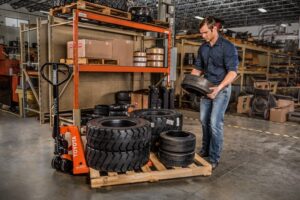
- Position the pallet jack at the side of the pallet. Align the forks with the gaps between the pallet boards.
- Make sure the forks are fully inserted into the pallet to ensure stability.
- Adjust the width of the forks to match the width of the pallet.
- Ensure the load is evenly distributed on the pallet to maintain balance and stability.
Step 4: Lifting and Moving the Pallet Jack
With the pallet jack properly loaded, it’s time to lift and move the load:
- Stand behind the pallet jack and firmly grasp the handle.
- Pump the lever to raise the forks off the ground. Use smooth and even motions.
- Push the pallet jack forward once the forks reach the desired height, using your body weight to steer it.
- Turn the handle in the desired direction while maintaining a steady pace to change direction.
- Slow down or stop the pallet jack gradually to avoid sudden jolts that could compromise the load’s stability.
- Use caution when approaching corners or narrow spaces to prevent accidents.
Step 5: Unloading the Pallet Jack
When it’s time to unload the pallet, follow these steps:
- Position the pallet jack in front of the desired location for unloading.
- Slowly lower the forks by operating the pump lever, keeping an eye on the load, and ensuring it is stable.
- Once the load is safely on the ground, carefully remove the forks from beneath the pallet.
- If necessary, secure the unloaded pallet using straps or other appropriate means.
Mastering a pallet jack can significantly enhance your efficiency and safety when handling heavy loads. By following these step-by-step instructions and practicing good safety measures, you’ll know how to use a pallet jack and perform like an expert in no time. Always prioritize safety, regularly inspect your pallet jack, and seek professional training if necessary. Happy pallet moving!
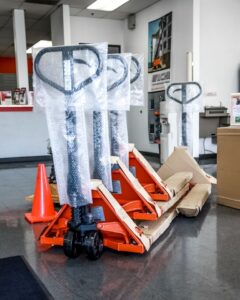
At Toyota Material Handling Solutions, we take pride in offering a wide range of reliable and high-quality pallet jacks for sale for various industries. Our selection includes renowned brands such as Toyota, Tora-Max, Heli, and Noblelift, ensuring you can access the best equipment for your specific requirements. Contact us to get a list of new pallet jacks for sale.
Do You Need a Facility Energy Audit?
A facility energy audit is when a knowledgeable and reliable person from an experienced material handling solutions provider assesses your energy use and facility layout. The goal is to find areas where you could potentially enhance efficiency and reduce operational expenses by utilizing forklift power options and optimizing facility power layouts such as storage and charging locations.
Performing a facility energy audit is helpful for two reasons:
- You get recommendations customized to your particular application and business operations, emphasizing practical solutions.
- You get ideas you can implement immediately or later when replacing existing equipment, providing an opportunity to prepare for the changes and budget for them in advance.
These recommendations typically include the following:
- Process enhancements
- Reorganizing your current fleet
- Investing in new charging systems, batteries, or other equipment
Through the implementation of the suggested solutions, you can potentially experience a return on investment in several areas, including:
- Energy conservation
- Reduced equipment costs
- Increased throughput
- Recovered storage or charging space that can generate income
- Improved operator productivity, comfort, and satisfaction
FACILITY ENERGY AUDIT PROCESS
Here are the seven areas typically evaluated during a facility energy audit:
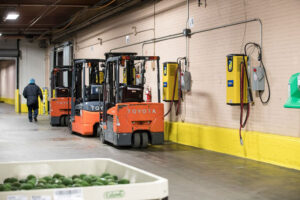
1. Charging Stations: With the aid of an electrician or facilities manager, auditors will inspect your current battery charging station to evaluate several areas, including:
- Incoming line voltage
- Types and quantity of chargers employed
- Area occupied
- Position of the charging station to other operations and spaces
2. Battery Storage: The auditors will also assess your current battery storage facilities and practices, considering factors like:
- Quantity of batteries stored
- Method of storage
- Number of trucks supported
- Amount of facility space occupied by the batteries
3. Forklift Specifications: The auditors will evaluate your fleet, considering data including:
- Size (number of trucks and capacity)
- Age
- Technology mix
- Usage
- Additionally, a data-logging device may be installed on one or more of the trucks at your facility for around a week to collect information on actual energy consumption.
4. Fueling Stations: Auditors will inspect IC fueling stations from multiple perspectives. They may evaluate the following:
- Number of trucks serviced by the stations
- Amount of fuel consumed
- Frequency of refueling requirements
- Location of the stations to other vital areas and operational spaces
5. Application: The auditors will watch the equipment in operation to pinpoint significant performance requirements. Although the list is extensive, some crucial aspects analyzed include: 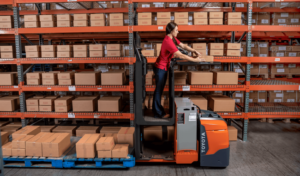
- Number of shifts operated
- Required lifting height of your equipment
- The intensity of your duty cycle
- Maximum load weight transported
- Break schedule for opportunity charging
- UL requirements
- Other special needs like connector type, connector color, spacers, or tray adders
6. Maintenance Areas: Auditors will also observe and assess battery swapping, watering stations, and other maintenance activities, including:
- Type of watering systems and other equipment used
- Space and layout designated for maintenance
- Tools and accessories provided to operators and technicians to carry out maintenance tasks
7. Facility Power Considerations: The auditors will examine not just your usage capacity (the maximum power capacity that your facility can provide to your equipment) but also the following:
- Electrical systems that your facility is currently operating
- Current overall throughput (the daily amps consumed)
- Throughput during peak seasons
GET EXPERT HELP WITH YOUR FACILITY ENERGY AUDIT
For more in-depth information on facility energy audits, download Toyota Material Handling’s 28-page white paper: Exploring Forklift Energy Solutions for Maximum ROI.
Developing and implementing a successful energy adoption strategy can enhance efficiency and lower operational costs. To ensure a successful facility energy audit, let us help. If you’re in Los Angeles County, contact us to schedule an appointment with an expert today.
How To Choose a Tora-Max Pallet Jack or Stacker
You want equipment that won’t shy away from a challenge when working hard. The all-new Compact, Second-Generation Electric Walkie Pallet Jack and Tora-Max Walkie Stacker help transport materials quickly and efficiently. Learn more about these units and why they should be part of your fleet.
Compact Tora-Max Electric Walkie Pallet Jack 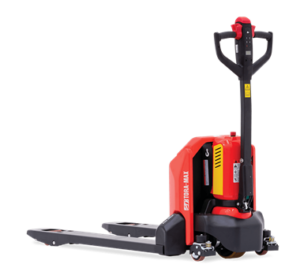
Exchangeable Lithium-Ion Battery
The Compact Tora-Max Electric Walkie Pallet Jack is a versatile, lightweight, cost-effective solution for quickly lifting pallets. The cartridge-style lithium-ion battery increases productivity and reduces downtime, reducing the need to recharge the battery frequently. With the option to charge the battery inside and outside your truck, and an optional second battery pack, you can increase run time to stay on the move.
Ergonomic Controls
The Tora-Max Electric Walkie Pallet Jack features a control handle, turtle button, pin code panel, and electric lift/lower buttons that are easy to reach for convenient operation.
Maintenance-Free Battery 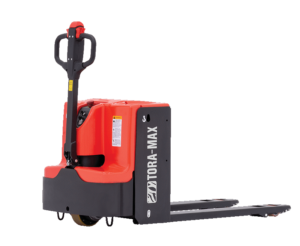
The Tora-Max Electric Walkie Pallet Jack has a maintenance-free, sealed lead-acid battery and a built-in charger to reduce operating costs and minimize downtime.
Durable Components
The Tora-Max Electric Walkie Pallet Jack is a durable and efficient lift with heavy-duty chassis, polyurethane drive tires, and a steel battery cover for protection. It also includes exit rollers for easy entry and exit on and off pallets and is powered by an efficient AC drive motor.
Tora-Max Walkie Stacker
Versatile Stacker
The Tora-Max Electric Walkie Stacker is versatile and maneuverable, with a load capacity of up to 2,600 lbs. It has pinwheel capability for tight spaces and adjustable base legs for stability with various load sizes. Click here to watch a video of the Tora-Max Walkie Stacker in action.
Operator Comfort
The Tora-Max Walkie Stacker easily navigates tight spaces while providing operator comfort and control. It features lift and lower controls, ergonomic hand grips, and fingertip controls for efficient operation.
24V Lithium-Ion Battery with Built-In Charger 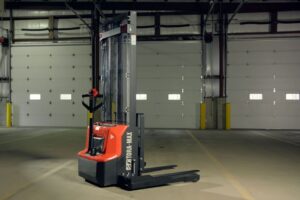
The Tora-Max Walkie Stacker has a 24-volt lithium-ion battery and built-in charger for quick and dependable operation. It also includes an LCD Battery Discharge Indicator with Hour Meter that displays battery usage, fault codes, and working hours.
Do you need help choosing which forklift to buy? We help businesses in Los Angeles County secure new, used, and rental forklifts. Contact us here to talk to a material handling specialist today.
Tuning Forklifts for Optimal Performance
When it comes to forklifts, there’s no such thing as a one-size fits all. After all, what works for a small mom-and-pop retail store may not work as well for a high-throughput forging application. Options such as lights and attachments allow you to customize each forklift to fit your needs, but did you know that adjusting forklift settings can be just as critical to optimizing performance and efficiency?
Many forklifts today come standard with pre-set performance and operational settings that can be adjusted through either a built-in multi-function display or an external device such as a laptop. Toyota’s Core Electric and 3-Wheel Electric models, for example, each have over 60 different parameters used to fine-tune forklift performance. Programmable passwords help prevent unauthorized users from accessing these settings.
Settings on Toyota Forklifts are highly adjustable as most parameters have eight or more levels of adjustment. Understanding how these settings affect forklift operation is the first step in realizing productivity and efficiency gains. Below are a few examples of these parameters along with how they may affect your operation. If you feel like you may benefit from optimizing your forklift’s operation, please reach out to your authorized Toyota dealer for expert support and service.
Tuning Your Forklift
Toyota Forklift Acceleration, Speed, and Braking Adjustments
Travel/Acceleration -Adjusting these speeds on the forklift may increase productivity or allow the operator to slow down when necessary. These settings can also save energy in applications where quick acceleration or faster travel speeds are unnecessary.
Accelerator Pedal Response* – Adjusts sensitivity to the initial depression of the accelerator pedal. Higher settings will reduce the delay between when the pedal is depressed and when the forklift begins to accelerate.
Rollback Speed* – Trucks with the rollback feature have a momentary delay followed by a controlled descent when the accelerator pedal is released while on a grade. This setting allows the travel speed and time before rollback to be adjusted.
Over Speed Alarm – An alarm sounds when the forklift exceeds a pre-set travel speed.
Regenerative Braking* – Adjusts how quickly the truck slows down when the operator’s foot is removed from the accelerator pedal. The strength of the “plugging” response can also be adjusted (when travel direction is switched between forward and reverse).
Toyota Forklift Maintenance, Lift, and Power Adjustments
Hydraulic Functions – Lift, lower, tilt, and attachment speeds are all adjustable. This includes starting, inching, maximum, acceleration, and deceleration settings. These settings can also provide energy savings in applications where faster hydraulic speeds are not necessary.
Lift Interrupt Level* – Used to tune the depth of discharge of a battery before the truck reaches lift interrupt. When the battery reaches the set level, the lift function will be disallowed. This allows the forklift to be matched to the battery size and type that is installed.
Planned Maintenance Hour Meter – An alarm sounds to inform the operator when the forklift is due for planned maintenance. The maintenance period can be adjusted and the alarm can be overridden.
Engine Auto Off/Auto Power Off – Engine (IC models) or battery power (electric models) will automatically turn off during a certain period of inactivity. The amount of time before it turns off can be adjusted or the setting can be turned off entirely.
Toyota Forklift Detection System Adjustments
SEnS and SEnS+ Smart Environment Sensors– Toyota forklifts equipped with SEnS or SEnS+ allow tuning to adjust parameters such as the distance at which a pedestrian or object is detected and the type of indicator that is used based on the distance.
*Applies to electric forklifts only.
Tips for Effective Order Picking
Order picking is one of the most critical processes in a warehouse. It is a complex task that requires speed, accuracy, and efficiency to ensure the right products get to the right customers on time. Here are some essential tips to ensure you get the most out of your order-picking process.
1. Create a Labeling System
A practical labeling system for your warehouse is essential to streamline the order-picking process. Ensure labels are clear, legible, and easy to read from a distance. Utilize color coding and standard symbols to simplify navigation even further.
2. Organization is Key
Being organized plays a crucial role in order picking accuracy and efficiency. Put like items together, separate them by size or type, and assign specific warehouse areas to them. Additionally, it would help to organize your warehouse so that frequently picked items are easily accessible and require minimal travel time for workers.
3. Use Advanced Technology
Innovative technologies are coming out daily to make work easier and more efficient. Voice technology and bar-code scanners can help boost accuracy and speed up order fulfillment times. RFID tracking systems provide real-time visibility over inventory levels across multiple warehouses simultaneously. And Smart Environment Sensors provide operators with pedestrian and object detection. However, it is essential to use these technologies cautiously as they can lead to errors if not properly implemented or maintained.
Want to learn more? Click here to read our blog post about six order-picking technologies and the benefits of each one.
4. Embrace Automation
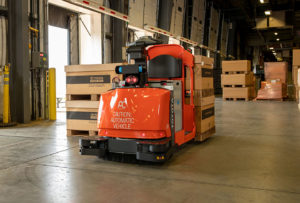
Automated systems such as conveyor belts or robotic arms can help speed up the order-picking process and reduce errors due to human error. Automated guided vehicles (AGVs) can move stock around without human intervention. Autonomous mobile robots can handle hundreds of daily tasks and thousands of orders every week. Investing in automation technology can be costly upfront, but it will pay off overall with increased efficiency and accuracy.
5. Put Safety First
Safety should always be a top priority when working in a warehouse environment. To protect workers, provide plenty of safety gear, such as gloves, protective clothing, goggles, etc. Create clear pathways throughout the warehouse so workers do not trip over boxes or other obstacles. Train employees to use any automated systems or manual processes used in order picking.
Click here for more safety and training tips.
6. Get Expert Help
If you have questions about how to set up your warehouse effectively, we can help. Our material handling solutions experts have decades of knowledge and training to help you choose the right products and solutions for your needs. Contact us to set up a free consultation. We can also help with operator safety training classes at your location.
Order picking is essential to any successful warehouse operation, but it does not have to be challenging. By utilizing clear labeling systems, practicing good organization techniques, taking advantage of modern technologies, embracing automation, and putting safety first, you can optimize your order-picking process for greater efficiency and accuracy with relative ease. Consider these tips when setting up warehouse operations to get orders out faster while minimizing errors!
